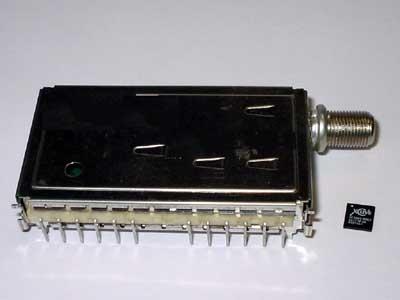TV Tuner on a Chip

A traditional "can" TV tuner next to its tiny Xceive chip replacement
There can be no better illustration of the power of digital circuitry to inspire new functions in new shapes than this picture of a traditional "can" TV tuner (so-named because of the aluminum shielding that protects the circuits inside from interference). You might recognize the familiar F-connector input for a TV antenna or cable signal. Can tuners are ubiquitous. They're in TVs, DVD recorders, VCRs, multimedia computers - any component that has to receive analog TV signals. The tiny black square just to the right of the can tuner is a digital chip from Xceive that replaces an entire thing, and for a fraction of the cost!
While the picture, supplied by Xceive, exaggerates the size difference (to be fully equivalent, their chip also needs an F-connector and a few tiny bits of external circuitry), it is a realistic depiction of the way an engineer will think of the Xceive chip: as something that can greatly simplify a design as well as enabling completely new products. The chip is compatible with any of the global TV standards, improving life for an engineer who has had to use separate can devices depending on the country his products are to be used in. It's so small that it can be built into a tiny USB device that plugs to a laptop computer, turning it into a universal-use TV receiver. And the chip tunes channels so rapidly - in a few milliseconds - that with two of them you can have not only a picture-in-picture function but multiple pictures-in-picture. The Xceive demo had about a dozen subscreens fed from one tuner chip producing subpictures that, while not at full TV frame rates, updated rapidly enough for the breaking-news junkie or sports fan. You can expect to find the Xceive chip in quite a few products - but only after you take off their covers and look real hard.
Check out more CES news. Back to Homepage What's New on S&V
- Log in or register to post comments



































































